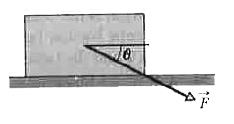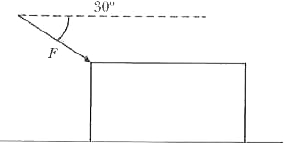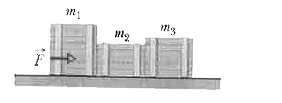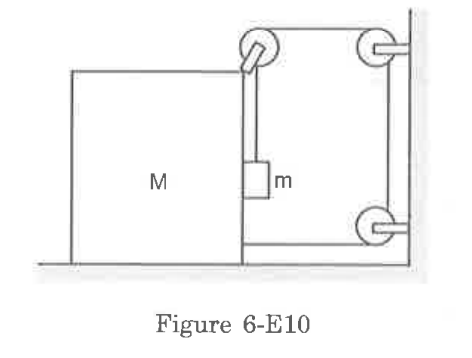A person pushes horizontally with a force of 220 N on a 55 kg crate to move it across a level floor. The coefficient of kinetic friction between the crate and the floor is 0.35. What is the magnitude of (a) the frictional force?
To find the magnitude of the frictional force acting on the crate, we can follow these steps:
Step 1: Identify the given values
- Force applied (F) = 220 N
- Mass of the crate (m) = 55 kg
- Coefficient of kinetic friction (μk) = 0.35
- Acceleration due to gravity (g) = 9.8 m/s² (standard value)
Step 2: Calculate the normal force (N)
The normal force for an object resting on a horizontal surface is equal to its weight, which can be calculated using the formula:
N=m⋅g
Substituting the values:
N=55kg⋅9.8m/s2
N=539N
Step 3: Calculate the frictional force (f)
The frictional force can be calculated using the formula:
f=μk⋅N
Substituting the values:
f=0.35⋅539N
f=188.65N
Step 4: Round the answer
Since we typically round to two significant figures based on the given data:
f≈190N
Final Answer
The magnitude of the frictional force is approximately 190 N.
---
- Force applied (F) = 220 N
- Mass of the crate (m) = 55 kg
- Coefficient of kinetic friction (μk) = 0.35
- Acceleration due to gravity (g) = 9.8 m/s² (standard value)
The normal force for an object resting on a horizontal surface is equal to its weight, which can be calculated using the formula:
N=m⋅g
Substituting the values:
N=55kg⋅9.8m/s2
N=539N
The frictional force can be calculated using the formula:
f=μk⋅N
Substituting the values:
f=0.35⋅539N
f=188.65N
Since we typically round to two significant figures based on the given data:
f≈190N
The magnitude of the frictional force is approximately 190 N.
Topper's Solved these Questions
- BOOK - RESNICK AND HALLIDAYCHAPTER - FORCE AND MOTION-IIEXERCISE - CHECKPOINTS5videos
FORCE AND MOTION-II
- BOOK - RESNICK AND HALLIDAYCHAPTER - FORCE AND MOTION-IIEXERCISE - PROBLEMS33videos
FORCE AND MOTION-II
- BOOK - RESNICK AND HALLIDAYCHAPTER - FORCE AND MOTION - I EXERCISE - PRACTICE QUESTIONS (Integer Type)3videos
FORCE AND MOTION - I
- BOOK - RESNICK AND HALLIDAYCHAPTER - GAUSS' LAW EXERCISE - PRACTICE QUESTIONS (INTEGER TYPE)3videos
GAUSS' LAW
Similar Questions
A 3.5 kg block is pushed along a horizontal floor by a force →F of magnitude 15 N at an angle θ=40∘ with the horizontal (Fig. 6-33). The coefficient of kinetic friction between the block and the floor is 0.25. Calculate the magnitudes of (a) the frictional force on the block from the floor and (b) the block's acceleration.
 View Solution
View SolutionA crate of mass m is pulled with a force F along a fixed right angles horizontal trough as in figure. The coefficient of kinetic friction between the crate and the trough is μ. Find the value of force F required to pull it along the trough with constant velocity.
 View Solution
View Solution
Knowledge Check
- Question 1 - Select One
A forward horizontal force of 12 N is used to pull a 240 N crate at constant velocity across a horizontal floor. The coefficient of friction is
A0.5B0.05C2D0.2 - Question 2 - Select One
You want to apply a force on a box so that it moves with constant speed across a horizontal floor. The coefficient if kinetic friction between the box and the floor is μk. Of the flur following cases, the force you apply on the box will be smallest when you
Apush it with a force applied horizontally at an angle 0<θ<90∘ in downword direction.Bpull it with a force applied horizontally at the same angle as in (A), in upward direction.Cdo either (A) or (B) since the applied force is the same.Dpush or pull with a force applied horizontally. - Question 3 - Select One
A force of F = 12.0 N is applied to a 8.00 kg block at a downward angle of 30∘ as shown in the figure.

The coefficient of static friction between the block and the floor is 0.700 and the coefficient of kinetic friction is 0.400. What is the magnitude of the frictional force on the block?A19 NB59 NC12√3ND6√3N
A factory worker pushes a 25.0 kg crate downward at an angle of 30∘ below the horizontal a distance of 6.0 m along a level floor.
(a) What magnitude of force must the worker apply to move the crate at constant velocity, if the coefficient of kinetic friction between the crate and floor is 0.3 ?
(b) How much work is done on the crate by this force when the crate is pushed a distance of 6.0 m?
(c) How much work is done on the crate by friction during this displacement ?
(d) How much work is done by the normal force and by gracity ?
(e) What is the total work done on the crate ? Take g=10m/s2View SolutionFigure 6-47 shows three crates being pushed over a concrete floor by a horizontal force F of magnitude 425 N. The masses of the crates are m1=30.0kg,m2=10.0kg,andm3=20.0kg The coefficient of kinetic friction between the floor and each of the crates is 0.700. (a) What is the magnitude F32 of the force on crate 3 from crate 2? (b) If the crates then slide onto a polished floor, where the coefficient of kinetic friction is less than 0.700, is magnitude F32 more than, less than, or the same as it was when the coefficient was 0.700?
 View Solution
View SolutionA block of mass m slips on a rough horizontal table under the action of horiozontal force applied to it. The coefficient of friction between the block and the table is μ. The table does not move on the floor. Find the total frictional force aplied by the floor on the legs of the table. Do you need the friction coefficient between the table and the floor or the mass of the table ?
 View Solution
View SolutionA block of mass 0.1 is held against a wall applying a horizontal force of 5N on block. If the coefficient of friction between the block and the wall is 0.5, the magnitude of the frictional force acting on the block is:
View SolutionA block of mass 0.1 kg is held against a wall by applying a horizontal force of 5 N on the block. If the coefficient of friction between the block and the wall is 0.5, then the magnitude of the frictional force acting on the block is
View Solution

